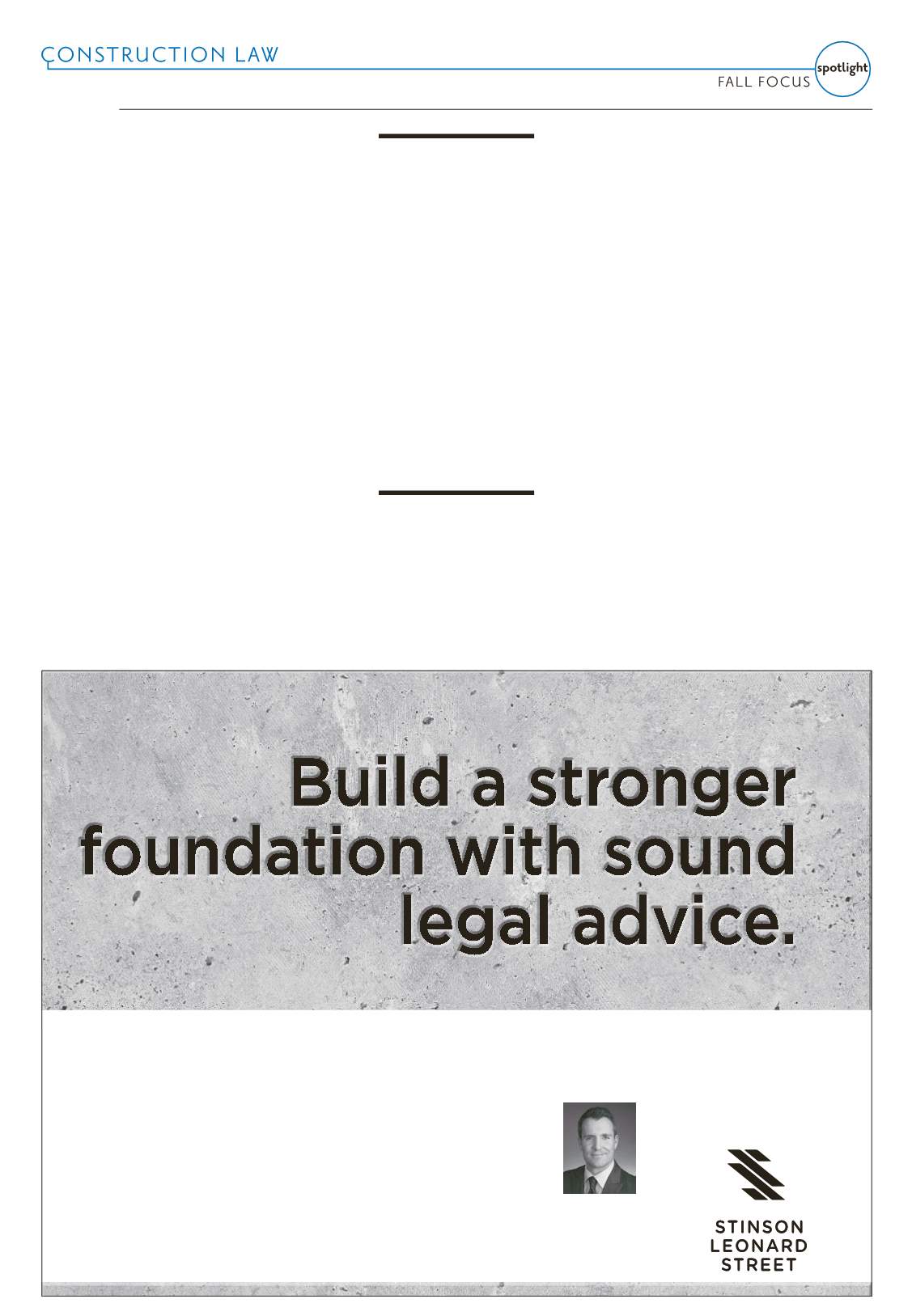
September 2-September 15, 2015
—
COLORADO REAL ESTATE JOURNAL
— Page 29B
We advise clients on all types of construction-related litigation matters. Forming one of the
largest dedicated practices of its kind, our experienced construction attorneys are known for
providing practical and timely representation in an industry where time literally is money.
For more information,
recession and attendant
rise in unemployment,
and the urgent need for
infrastructure improvements,
supported the creation of
HPTE and its charge to
seek out opportunities for
public partnerships and
other innovative and efficient
means of completing surface
transportation infrastructure
projects. (See id. § 43-4-802.)
Although Colorado
requires a performance and
payment bonds for public
works projects, there is no
specific legislation requiring
performance and payment
bonds for P3 projects and
there remains an open issue
in Colorado as to whether
a P3 project is a “public
works” project per applicable
Colorado statute.
Two P3 projects of note in
the Denver metropolitan area
are the Fast Tracks Eagle P3
Project and the expansion of
U.S. 36 between Denver and
Boulder.
The Eagle P3 Project
includes the construction
of three new commuter rail
lines and a commuter rail
maintenance facility and is
scheduled to open in 2016.
One of the commuter rail
lines will connect Denver
International Airport directly
to Union Station. The Eagle
P3 Project is essential not just
to travelers seeking quick and
inexpensive transportation to
and from DIA, but to help ease
the flow of people to and from
Denver and surrounding areas
to get to and from downtown
more easily.
The basis of the Eagle
P3 Project is a concession
agreement between RTD, a
regional transportation district,
and a “concessionaire” selected
through a competitive proposal
process. (Background on the
Eagle P3 Project can be found
at
.
com/ep3_77.)
The “concessionaire”
for the project is Denver
Transit Partners, a special
purpose company owned by
Fluor Enterprises, Uberior
Investments and Laing
Investments.
A number of equity,
construction, and other firms
are involved as well. The Eagle
P3 Project is a $2.2 billion
capital project comprised of
federal funds, RTD sales tax
bonds and private equity DTP.
The Eagle P3 Project was
accepted by the Federal Transit
Authority as part of its Public-
Private Partnership Program,
and received a $1.03 billion
Full Funding Grant Agreement
on August 31, 2011.
The Eagle P3 Project
concession agreement requires
DTP to design, build, finance,
operate and maintain the
East Rail Line, Gold Line,
Northwest Electrified Segment
(segment 1 of the Northwest
Rail Line) and Commuter
Rail Maintenance Facility
project under a single contract.
agreement provides that RTD
will retain all assets while
shifting much of the risk of
designing and building the
project to DTP. DTP has
arranged for approximately
$400 million of private
financing for the project
through the issuance of bonds.
RTD and DTP negotiated and
agreed that DTP would post
bonds, or a letter of credit or
other surety to provide some
degree of security for the
subcontractors and suppliers
for this project.
The Eagle P3 Project also
incorporates 17 Alternative
Technical Concepts into the
project’s scope that saved RTD
an estimated $300 million
and further reduced overall
operations and maintenance
expenses.
Another example of a
local P3 project is Phase II
of the expansion of U.S.
36, which is CDOT’s first
P3 project. (Background
information on Phase II of
the U.S. 36 expansion can
be found at
.
codot.gov/news/2013-news-
releases/04-2013/cdot-and-
hpte-select-concessionaire-to-
complete-the-us-36-express-
lanes-project; see also http://
/ colorado-
p3-completes-first-phase-of-
ambitious-highway-widening-
project/.)
The concessionaire for
this project is Plenary Roads
Denver, a consortium that
includes the Plenary Group,
Ames Construction, Granite
Construction, HDR, Transfield
Services and Goldman Sachs.
Phase 1 of the project
was recently completed and
includes a newly widened
segment between Federal
Boulevard and 88th Street.
Phase I of the expansion of the
U.S. 36 corridor was not a P3
project.
Phase 2 of the Boulder
U.S. 36 project, which is
a P3 project, includes the
construction of express lanes
for HOV/bus rapid transit/
and tolled single-occupancy
vehicles between 88th Street
and Table Mesa in Boulder
as well as reconstructing the
general traffic lanes on U.S. 36.
There are other components
of the Phase 2 project that
involve bridgework, installing
bikeways and improvement of
an existing RTD station.
Under its 50-year agreement
with CDOT and HPTE, Plenary
Roads Denver also assumed
responsibility to operate and
maintain the entire U.S. 36
corridor between I-25 and
Table Mesa in Boulder and the
I-25 Express Lanes between
downtown Denver and U.S. 36.
These two P3 projects
portend favorably for the
anticipated increase in P3
projects in Colorado to build,
finance, and maintain critical
infrastructure projects in the
years to come.
Part of the
reason for the
increase in use
of the P3 model
of project delivery
is the urgent
need for
infrastructure
repairs and
improvements
coupled with
the absence of
adequate public
funding.


